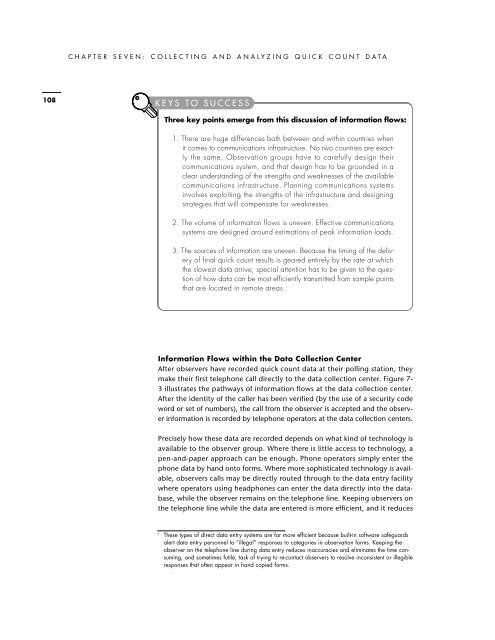The Quick Count and Election Observation
The Quick Count and Election Observation
The Quick Count and Election Observation
Create successful ePaper yourself
Turn your PDF publications into a flip-book with our unique Google optimized e-Paper software.
CHAPTER SEVEN: COLLECTING AND ANALYZING QUICK COUNT DATA<br />
108<br />
Three key points emerge from this discussion of information flows:<br />
1. <strong>The</strong>re are huge differences both between <strong>and</strong> within countries when<br />
it comes to communications infrastructure. No two countries are exactly<br />
the same. <strong>Observation</strong> groups have to carefully design their<br />
communications system, <strong>and</strong> that design has to be grounded in a<br />
clear underst<strong>and</strong>ing of the strengths <strong>and</strong> weaknesses of the available<br />
communications infrastructure. Planning communications systems<br />
involves exploiting the strengths of the infrastructure <strong>and</strong> designing<br />
strategies that will compensate for weaknesses.<br />
2. <strong>The</strong> volume of information flows is uneven. Effective communications<br />
systems are designed around estimations of peak information loads.<br />
3. <strong>The</strong> sources of information are uneven. Because the timing of the delivery<br />
of final quick count results is geared entirely by the rate at which<br />
the slowest data arrive, special attention has to be given to the question<br />
of how data can be most efficiently transmitted from sample points<br />
that are located in remote areas.<br />
Information Flows within the Data Collection Center<br />
After observers have recorded quick count data at their polling station, they<br />
make their first telephone call directly to the data collection center. Figure 7-<br />
3 illustrates the pathways of information flows at the data collection center.<br />
After the identity of the caller has been verified (by the use of a security code<br />
word or set of numbers), the call from the observer is accepted <strong>and</strong> the observer<br />
information is recorded by telephone operators at the data collection centers.<br />
Precisely how these data are recorded depends on what kind of technology is<br />
available to the observer group. Where there is little access to technology, a<br />
pen-<strong>and</strong>-paper approach can be enough. Phone operators simply enter the<br />
phone data by h<strong>and</strong> onto forms. Where more sophisticated technology is available,<br />
observers calls may be directly routed through to the data entry facility<br />
where operators using headphones can enter the data directly into the database,<br />
while the observer remains on the telephone line. Keeping observers on<br />
the telephone line while the data are entered is more efficient, <strong>and</strong> it reduces<br />
3<br />
<strong>The</strong>se types of direct data entry systems are far more efficient because built-in software safeguards<br />
alert data entry personnel to “illegal” responses to categories in observation forms. Keeping the<br />
observer on the telephone line during data entry reduces inaccuracies <strong>and</strong> eliminates the time consuming,<br />
<strong>and</strong> sometimes futile, task of trying to re-contact observers to resolve inconsistent or illegible<br />
responses that often appear in h<strong>and</strong> copied forms.


